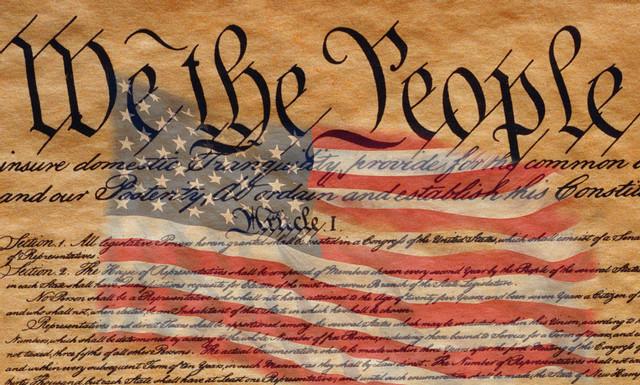


![]()

![]()
Constitutional Convention
Philadelphia, Pennsylvania
May 14 to September 17, 1787
As the Articles of Confederation were law, all citizens were bound to defend it. However, because of the weaknesses inherent in the Articles, many of the Founding Fathers wanted drastic changes. Those strongly advocating change were Alexander Hamilton and future president James Madison. The Articles could be amended, but only by unanimous vote of the states. This seemed insurmountable. Therefore, on January 21, 1786, the Virginia legislature invited each state to send delegates to Annapolis, Maryland to discuss ways to improve and strengthen the Articles. This meeting is called the Annapolis Convention.
The Annapolis Convention took place September 11, 1786 to September 14, 1786. Unfortunately, not many delegates attended. Only five states sent delegates for a total attendance of 12. Rhode Island did not send any delegates as it feared that any outcome would be detrimental to smaller states and advantageous to the larger states. Recognizing their small numbers, the 12 delegates called for a larger convention to be held in Philadelphia, Pennsylvania starting May 14,1787. This meeting came to be called the Constitutional Convention. History initially called the new meeting the Philadelphia Convention of 1787.
As soon as the delegates to the Constitutional Convention met in large enough numbers on May 25, 1787 they elected George Washington to preside over the convention as its president. A total of 55 delegates attended. The primary location was Independence Hall.
Though he was not elected secretary, James Madison took detailed notes every single day without being absent once. Madison published these under the title Notes of Debates in the Federal Convention of 1787. The notes are valuable to historians seeking a glimpse into the machination of one of the most important meetings in American history.
A key controversy was balancing the needs and rights of the less populated states and the needs and rights of the more populated states. Several plans were introduced. The Virginia Plan and the New Jersey Plan were at polar opposites. The Virginia Plan favored the more populated states with all representation in proportion the population. The New Jersey Plan favored the less populated states by giving each state equal representation, not based on population. In the end a compromise between the two was forged called the Connecticut Compromise.
Connecticut Compromise
The Connecticut Compromise divided the federal legislature (Congress) into two chambers: House (lower) and Senate (upper). The lower chamber would have representation based on proportion to the population. Thus, more populated states would have more representatives than less populated states in this lower chamber. The upper chamber would be composed of two senators from each state regardless of population. Thus, a less populated state like Connecticut could have representational power in that upper chamber equal to a more populated state like Virginia. Further, all bills generating revenue (raising taxes, fees) must originate in the lower chamber.
The Connecticut Compromise passed on July 16, 1787 by a vote of seven to six.
Slavery an Issue: Three-fifths Compromise
States that did not allow slavery were upset that states that did have slavery might have their slaves counted toward representation in the lower chamber. States with many slaves liked this concept as it would increase their number of representatives in the lower chamber. However, these same slave states did not want the same population of slaves to count as property to be assessed taxes for the state to pay to the government. The slaves states wanted to have their cake (slave representation in congress) and eat it too (no taxation value on "property" slaves.) Non-slave states wanted full taxation value and no representation for slaves. This led to the Three-fifths Compromise. This compromise counted each slave as three-fifths of a person for both purposes - representation in the lower chamber and assessment of taxes for each slave.
Slave Trade
The Constitutional Convention set as its priority the creation of a new form of government by replacing the Articles of Confederation with a new, stronger constitution. Therefore, it was understood that the abolition of slavery was not going to be discussed at this convention. Three slave states (Georgia, both Carolinas) would have departed the convention rendering it powerless.
Those against slavery, however, did make some headway for the future abolition of the importation of slaves (slave trade). The slave states were not ready for the passage of any articles banning the importation of slaves at that point in time. Therefore, a compromise was reached where Congress would have the power to abolish the slave trade, only not before the passing of 20 years from the ratification of the new constitution. Twenty years later this is exactly what happened.
On January 1, 1808, upon the request of then President Thomas Jefferson, Congress outlawed the importation of slavery to the United States. This date was the earliest allowed by the slave trade compromise at the Constitutional Convention of 1787.
Final Draft, Passage, and Signing
On June 23, 1787 the convention established the Committee of Detail, a committee chaired by John Rutledge, former governor of South Carolina. This committee was tasked with creating a formal draft of the constitution based on the proposals that passed. The convention adjourned from July 26 to August 6, 1787 to await the committees draft. After the draft was submitted debated ensued for a month.
Finally, on September 8, 1787 a new committee of 5 different members was created for the purpose of writing the final, official document that would come to be known as the Constitution of the United States. This committee was called the Committee of Style and Arrangement. One of the members, Gouverneur Morris (he was never governor, that is his first name) is credited as the chief draftsman of the Constitution. Morris is also credited with writing the preamble that beings with, "We the people..." The committee submitted the final document for signing on September 17, 1787. That day, 39 of 55 delegates signed the Constitution of the United States.
Ratification by States
September 17, 1787 is officially regarded as the date the U.S. Constitution was created. It's official ratification, however, is June 21, 1788 when New Hampshire became the ninth state to approve the new constitution. The Constitution required ratification by 9 of the 13 states pursuant to it's own Article VII before it could become the law of the land. After New Hampshire's vote Virginia, New York, North Carolina, and Rhode Island eventually ratified it to become the four newest states under the umbrella of the Constitution.
Congress under the Articles of Confederation formally acknowledged one September 13, 1788 that the Constitution had been officially ratified on June 21, 1788 with New Hampshire's vote. That congress then established March 4, 1789 as the start of the new government under the constitution. Thus, on Wednesday, March 4, 1789 the new Congress under the U.S. Constitution came into existence and the congress under the Articles of Confederation ceased to exist.
Start of New Government
The first day of the new U.S. Congress was March 4, 1789. It should also have been the date on which the first elected president George Washington took the presidential oath of office. However, after hearing of his election, there was not enough time for the newly elected Washington to get from his home in Virginia to the temporary capital city, New York by March 4. The Electoral College elected Washington the first president on February 4, 1789. By the time Washington received the news and made travel plans to get to New York City, March 4 had come and gone. Therefore, Washington took the oath of office for his first term on April 30, 1789. A statue of Washington at Federal Hall in New York City, where the oath took place, commemorates the inaugural.
The second term inaugural for Washington took place on March 4, 1793. All other elected presidents would take the oath on March 4 following an election until the inaugural date was changed by constitutional amendment to January 20 starting with the winner of the 1936 election. Thus, Franklin D. Roosevelt was inaugurated on March 4, 1933 for his first term and January 20, 1937 for his second term.
NEXT PAGE - Constitutional ConventionPlease e-mail your inquiry.